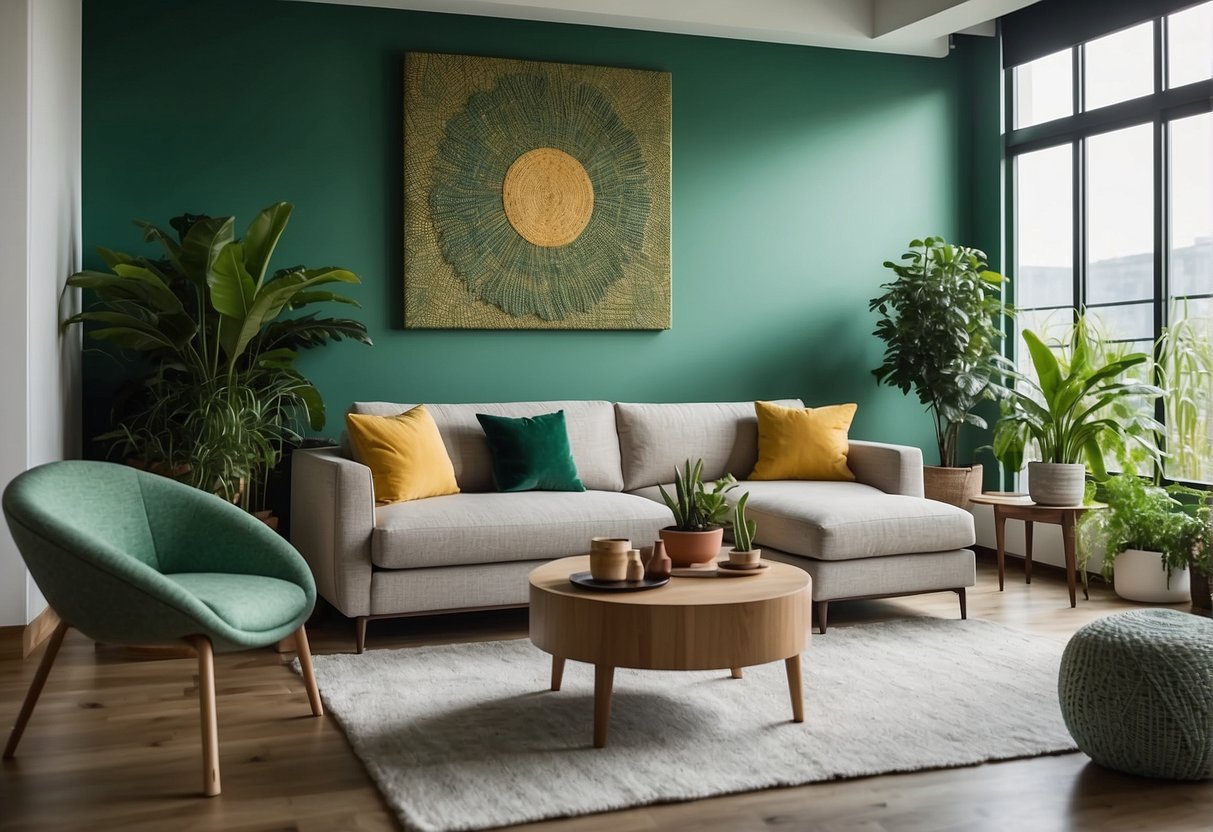As society leans into a greener future, eco-friendly home decor trends are taking center stage in 2024. Homeowners are increasingly seeking sustainable options that not only look good but also minimize environmental impact. This shift towards sustainability in interior design isn’t just about saving the planet, it’s also about creating healthier living spaces. From furniture crafted from renewable resources to energy-efficient lighting, these trends are all about merging style with eco-consciousness.

The demand for sustainable materials has given rise to a wealth of innovative decor options. Think bamboo, cork, and even upcycled goods revolutionizing the way homes are adorned. And it’s not just the materials that are getting a green makeover; the colors and textures of 2024 reflect nature itself. A focus on earthy tones and natural finishes brings the outside in, fostering a serene and organic atmosphere.
Yet, it’s not just about what products are made of, but how they’re produced. Ethical manufacturing processes and local sourcing are becoming key factors in purchasing decisions. Consumers are digging deeper, wanting to know the story behind their purchases, ensuring that their aesthetic choices align with their values. The rise of sustainable home decor trends in 2024 shows a collective commitment to a future where beauty and responsibility go hand in hand.
Defining Eco-Friendly Decor

Eco-friendly decor intertwines environmental consciousness with aesthetic appeal, prioritizing materials and methods that minimize harm to the planet. It’s about creating a sustainable lifestyle within the walls of one’s home, where every design choice reflects a commitment to nature and its preservation.
Principles of Sustainable Lifestyle
Sustainable living is founded on principles that reduce waste, promote recycling, and embrace renewable resources. When it comes to eco-friendly decor, it means choosing furniture and accents made from sustainable materials like recycled glass, reclaimed wood, or rapidly renewable resources such as bamboo. Energy-efficient lighting and low-VOC paints are also hallmarks of this approach, ensuring that every item in the home contributes to a healthier environment both indoors and out.
Biophilic Design in Modern Homes
Biophilic design takes this concept a step further by integrating direct or indirect elements of nature into home decor. This approach isn’t just about the use of plants; it’s about creating a connective experience to the outdoors through the use of natural light, natural materials, and nature-inspired textures and patterns. Biophilic design in modern homes often involves maximizing natural lighting and providing unobstructed views of the outdoors, promoting a sense of calm and well-being that comes from being in close contact with nature.
Material Matters

The shift toward eco-conscious living has profoundly influenced home decor trends, with materials taking center stage. Homeowners are increasingly preferential towards items that not only stand out aesthetically but also boast environmentally friendly credentials.
Embracing Natural Materials
Natural materials are at the forefront of eco-friendly design. They’re celebrated for their minimal environmental impact and biodegradable nature. Bamboo is a clear favorite due to its rapid growth rate and versatility, ideal for everything from flooring to decorative items. Additionally, rattan and cork are gaining popularity, prized for their sustainability and natural beauty. These materials are often seen in furniture, flooring, and as decorative accents, providing a touch of nature’s essence indoors.
The Rise of Upcycled Furniture
Upcycled furniture has carved a niche in eco-friendly home decor. Creative minds are transforming old, unwanted pieces into chic, one-of-a-kind items. Recycled materials find new life, reducing waste and offering a bespoke charm. Sustainable materials are key — with pieces crafted from reclaimed natural wood or textiles — each telling a unique story through their imperfections. This practice not only promotes sustainability but also adds a layer of personalization and history to the home’s decor.
Color and Texture Trends

When it comes to eco-friendly home decor in 2024, one will witness a strong inclination toward nature-inspired hues and diverse tactile experiences. Key considerations include the selection of sustainable materials and a color palette that pays homage to the great outdoors, thus fostering a serene and grounded ambiance.
The Return of Earthy Tones
Earth tones are making a prominent comeback, with a particular emphasis on various shades of green and brown. These colors invoke a sense of tranquility and are reminiscent of nature’s most fundamental elements. As seen in Forbes, the resurgence is about embracing the organics of yesteryear but with a contemporary twist. People are becoming more drawn to colors like olive green and terracotta, which pair well with natural fabrics such as linen and cotton to create eco-conscious interiors.
- Greens: Reflecting foliage and forest canopies.
- Blues: Mirroring skies and waters, especially tranquil shades that evoke a sense of peace.
- Yellows: Soft, warm hues that brighten spaces with a sunny, optimistic glow.
Textural Richness in Fabrics and Wallpapers
The texture is pivotal in adding depth and character to eco-friendly spaces. 2024 sees an increase in textural patterns on fabrics and wallpapers, infusing a more tactile experience into home decor. Sustainable materials like wool and velvet are appreciated not only for their aesthetic appeal but also for their durability and eco-friendly properties. In addition, the usage of stone textures in accents and features adds an organic touch to interiors, resonating with a trend highlighted by Elle Decor.
- Fabrics: Preference for natural fabrics, combining comfort with eco-friendliness.
- Wallpapers: Environmentally friendly papers featuring bold patterns and textures.
By embracing earthy tones and rich textures, one can create a living space that’s not only stylish and contemporary but also kind to the planet.
Design Elements and Furniture Choices

As 2024 ushers in new trends in home decor, a clear emphasis is seen on eco-friendly furniture that complements a sustainable lifestyle. Homeowners are leaning towards designs that are both aesthetically pleasing and kind to the planet.
Fluidity and Movement in Furniture Design
The latest furniture trends showcase a push toward fluidity and curves. Pieces are designed to create a sense of movement within a space. Dining chairs and nesting tables embody this trend with soft lines and undulating forms, offering an organic feel that contrasts with the rigid shapes of the past. Furniture isn’t just about looks; it’s about creating harmony with the natural world.
- Key features:
- Curved lines
- Smooth edges
- Organic shapes
Multipurpose Pieces and Space Optimization
Multipurpose furniture has become a cornerstone of eco-friendly furniture design. Homeowners are looking for dynamic statement pieces that serve multiple functions. This trend not only saves space but also resources, aligning perfectly with sustainable living goals. For example, nesting tables work individually and as an ensemble, adapting to various needs and reducing clutter.
- Key Pieces:
- Nesting tables
- Convertible sofas
- Extendable dining tables
Bold choices in furniture allow for personal expression while maintaining an eco-conscious approach. The customization trend is evident in the popularity of custom furniture, which promises a perfect fit for both the space and the owner’s values.
Lighting and Accents
The focus on sustainability has ushered in innovative lighting options and accessories that blend style with eco-consciousness. Not only do these trends cater to the aesthetic but also exemplify responsible design choices.
Sustainable Lighting Solutions
Consumers today are increasingly selecting energy-efficient lighting to reduce their carbon footprint. LED lighting options have taken center stage because of their low power usage and long lifespan. For a touch of nature, interior designers are also incorporating lighting fixtures made of natural elements like reclaimed wood or bamboo. These materials not only bring warmth and authenticity into a space but also champion the use of sustainable resources.
Accessorizing with Eco-Friendly Pieces
When it comes to accessorizing, eco-friendly pieces are a smart and stylish choice. Designers are utilizing biodegradable wallpapers that feature organic and recycled materials, ensuring that a room’s aesthetic is both unique and kind to the planet. Additionally, throw pillows made from organic cotton or recycled polyester are not just comfortable accents, but they also support sustainable practices within the textile industry. By choosing such items, homeowners can significantly contribute to the reduction of environmental impact.
Emerging Trends and Consumer Insights
In 2024, eco-friendly home decor trends are shaped significantly by innovative materials and a strong emphasis on personalized spaces that reflect individual tastes and values.
Eco-Innovation in Interior Design
The eco-innovation wave is cresting in interior design, leading to a surge of interest in sustainable materials and practices. Surveys reveal a pivot towards natural elements, with materials like bamboo, cork, and jute becoming popular due to their low environmental impact. Biophilic design, which fosters a deeper connection with nature, is not just a trend but a guiding principle in interior decor. Items such as living plant walls and sustainable natural fabrics are on the rise, mirroring the public’s growing environmental consciousness.
In interior design, trends like reclaimed wood furniture have gained traction as they marry sustainability with style. Eco-friendly practices are also becoming more innovative; for instance, some decor pieces now showcase recycled plastics and glass, transformed into stunning, aesthetic elements that boast both individuality and eco-consciousness.
The Significance of Individualized Spaces
As people spend more time at home, there’s a noticeable shift towards creating spaces that capture their unique personality and individuality. This personalization extends beyond mere aesthetics; it’s about creating environments that resonate with the inhabitants’ ethos and lifestyle choices. For example, a preference for maximalism could entail bold, expressive patterns and colors that are carefully chosen to not only make a statement but also ensure eco-friendliness.
Surveys are pointing out that individuals today are eager to express themselves through their living spaces, turning away from one-size-fits-all designs. They are increasingly looking for home decor options that can be tailored or customized, showing that the personal touch in interior design can go hand in hand with ecological responsibility.





